The aurora ceases to remain polar. Now it can be observed with the naked eye all over the world. Until 2022, tourists from all over the world rushed to see the clear lights in the northern regions. In the last year, the red glow can be seen… everywhere. Not always, of course, but very often. Auroras are dangerous for people with unstable psyches.
The impact of the aurora on the human psyche
Local residents of the Arctic noticed: the polar lights take away the minds of many. And this is not one of the series of intimidating horror stories. The Eskimos call this the “call of the North Star.” Russian Pomors introduced the concept of “measuring”. It refers to an unusual mental illness that occurs in several people at the same time. At one time, the famous polar explorer Amundsen encountered this strange phenomenon. He was the navigator of the Belzhik ship, which was wintering off the coast of Antarctica. Several members of the expedition “heard the call.” One of them ran away from the ship into the snowy expanses, and the other tried to kill Amundsen with an ax. Doctors who took part in polar expeditions discovered a pattern: almost all cases of polar rabies coincided with the activity of the aurora.
The most terrible ones coincided with flashes of red color. The number of such attacks of expeditionary rabies increased significantly in years with recorded peaks of solar activity, when the brightest auroras occurred. After a series of experiments, Soviet scientists found out that certain forms of auroras pulsate at a frequency that is close to the basic rhythms of the human brain, which causes a kind of malfunction in its work. And bright flashes of scarlet color coincide with a frequency close to the rhythms of the brain. They cause exacerbation of chronic diseases and seizures similar to epileptic ones.
Other experimental subjects, under the influence of such outbreaks, developed headaches and malfunctions of the vestibular apparatus. People prone to mental illness are susceptible to this type of influence: they feel an inexplicable need to become one with something majestic. The aurora is accompanied by active infrasound, which is not perceptible to the ear.
Infrasound is unpredictable: it is unknown what changes occur in the human brain and cardiovascular system. Therefore, to witness the northern lights means exposing yourself to an unknown danger to the body. Infrasound is the cause of many tragedies that occur at sea. Minor exposure to infrasound results in seasickness, moderate exposure causes disruption of brain function, sometimes to the point of loss of vision and hearing. It is believed that infrasound at 7 hertz is fatal to humans. Death occurs due to vibration of internal organs, which leads to cardiac arrest. Scientists believe that legends about sea sirens beckoning sailors are directly related to the aurora.
Nature of the aurora
The riddle of the mysterious lights was once solved by Mikhail Lomonosov. The sun emits charged particles – the solar wind, which, upon reaching the Earth, make the atmosphere shimmer with different lights. With the help of magnetic attraction, the planet “catches” the passing solar wind and directs it to where the magnetic poles are located. There, solar particles are instantly attracted to them, and from the collision of the solar wind with the atmosphere, energy appears, converted into light, which creates the northern lights.
The waves and overflows that a person sees occur at an altitude of 100 to 300 km. Observations of the aurora are naturally highly dependent on the weather. For example, unlike Chukotka, the warm Gulf Stream often causes the formation of dense clouds over the Kola Peninsula. But the Murmansk region and Karelia are easier to reach, so the main flow of tourists is directed to these areas. You just need to know that you can’t always see the aurora and not everywhere; Sometimes, in search of color tints, you have to drive all night or wait several days for the weather to improve.
The aurora is a natural phenomenon in which the upper layers of the Earth’s atmosphere glow in different colors. It can be northern (Aurora Borealis) or southern (Aurora Australis), depending on which hemisphere it appeared over. The North Pole, or Arctic, is more densely populated by people, so the term “northern lights” is used much more often. Only researchers of this region live at the South Pole, or Antarctica, so there is practically no one there to admire the polar lights.
From the surface of the earth, the lights look different. Sometimes it is a faint glow, more like a dense nebula. If you don’t know that these are the northern lights, you might not even notice them. Bright and saturated flashes look completely different. They appear in the sky in the form of stripes or flickering, and can move and change color. This light show lasts from a couple of minutes to several hours. This is exactly the kind of radiance that tourists who come to “hunt” dream of seeing.
If you look at it, the aurora is not exactly an earthly phenomenon. It occurs under the influence of solar activity. Flashes regularly occur on the surface of the star, as a result of which a mass of particles is thrown into space. This is the so-called “solar wind”. Particles spread throughout space and are attracted to other planets.
When the solar wind reaches Earth, they are attracted to the magnetic field. It forces particles to move along lines of force, towards the South or North Pole. That is why the aurora appears in certain places, and not across the entire surface of the planet.
As protons and electrons from the solar flare approach Earth, they collide with atmospheric particles. At this point, they transfer an electrical charge, releasing energy. The gas molecules that make up the atmosphere are excited. This process produces the glow that is visible from the ground. M. Lomonosov was the first to suggest a connection between the northern lights and the magnetic field. He conducted experiments using a glass ball from which the air was pumped out. The scientist passed discharges of electricity through it and observed the resulting lights of different colors.
The theories were later confirmed through research. For example, in 1882, as part of the International Polar Year, scientists found that flashes in the sky were moving around the North Pole. Later, a similar situation was discovered at the South Pole, calling these phenomena “an oval of aurora.”
Having understood the nature of the aurora, scientists were able to cause it artificially. For example, during the study of the geomagnetic field in the United States, nuclear explosions were carried out, which provoked a glow in the region of the poles. The explosions created disturbances in the geomagnetic field, and a stream of charged particles caused a glow in the upper layers of the atmosphere. Another experiment was carried out jointly by the USSR and France. A particle accelerator was launched into the sky, emitting electrons. They were attracted by the geomagnetic field over the North Pole and provoked aurora over the Arkhangelsk region.
The Northern Lights always look different. Flashes in the sky are distinguished by colors, their saturation, as well as formed figures. Scientists classify aurora according to different criteria. For example, by shape:
– Ribbons. Looks like horizontal stripes in the sky. Their number and location may vary.
– Stains. This is a glow without a clear shape or boundaries.
– Rays. Narrow strips of light directed from bottom to top.
These forms can be identified even by a person who sees the radiance for the first time. They appear frequently and are clearly visible in dark skies. The International Cloud Atlas, used by meteorological organizations, describes more forms, but only experienced people or specialists can distinguish them.
Also, the aurora comes in different brightnesses. The intensity is assessed by eye, in points from 1 to 4. The weakest value is 1, this level of brightness is similar to the Milky Way. The most intense indicator is 4. It is comparable to the brightness of the full moon illuminating the Earth on a dark night.
Another striking characteristic is the color. The glow can be very different, depending on what height from the ground it appears:
– up to 120 km – blue and violet tones;
– 120-150 km – yellow and green;
– from 150 km – red.
The color is also affected by which gases in the atmosphere the solar wind encounters. Nitrogen, oxygen and hydrogen atoms change shades of glow, depending on which gas predominates. The Northern Lights are never monochromatic. The shades flow into one another, sometimes creating completely unexpected combinations.
The aurora usually occurs over the North and South Poles. But not every point in these areas is convenient for observing the sky. Here is a list of countries where the lights are visible quite well:
Norway (Spitsbergen);
Finland (Ivalo);
Sweden (Abisko);
America (Alaska);
Iceland (Akureyri);
New Zealand (Stewart Island).
The Northern Lights are also flaring up over Russia. It is best seen at a latitude of 67-70 degrees. Here are the areas where you can see this extraordinary natural phenomenon with your own eyes:
Kola Peninsula (Murmansk);
Arkhangelsk region (Arkhangelsk);
Komi Republic (Vorkuta);
Krasnoyarsk region (Khatanga).
The easiest place to see the northern lights is in the Murmansk region, on the Kola Peninsula. It’s easy to get here; for example, a plane from Moscow flies to Murmansk in about two hours. The region is an active tourist destination. There are many hotels, well-developed transport links between the areas. Special tours and excursions are organized for Northern Lights hunting, so travelers can easily observe this amazing phenomenon.
It is important to consider that the lights are clearly visible only outside the city. Electric lighting makes the sky too bright, so colorful flashes in the city are difficult to observe. Excursions must travel outside populated areas. In the Arctic, this is an endless tundra, so the light in all its splendor is clearly visible in the sky.
Scientists know quite a lot about the nature of the northern lights, so they can predict its appearance with high probability. Forecasts are usually made 27 days in advance, but more accurate data can be obtained 3 days in advance. To predict the aurora, several factors are analyzed:
– KP index, showing the strength of the geomagnetic activity of the planets.
— Sunspots and coronal holes on the Sun. They precede the ejection of plasma from the surface, which results in the appearance of the solar wind.
— The speed and density of the plasma flow flying towards the Earth.
— A cloud front over an area where aurora may occur.
This data is analyzed by professional meteorologists. Amateurs only track the KP index. If it rises to 4-5 units, it is considered that the probability of the aurora appearing is very high. It is on the basis of this indicator that most applications that build a forecast of the northern lights are created.
If you analyze all the meteorological data, you can predict the appearance of flashes in the sky quite accurately. But a good forecast gives absolutely no guarantee that the aurora will be visible in a particular place. The fact is that the data is analyzed for the entire auroral oval, that is, the oval zone surrounding the Earth’s magnetic belt. The diameter of such an oval is about 3000 km, and it can expand. The forecast shows that the aurora will appear somewhere in this area. And if the sky in this area is clear, people will be able to see colorful flashes.
It turns out that scientists predict the aurora with a good probability, but within the entire magnetic pole. That is why the “hunt” for aurora is popular in the polar regions. Local guides, using meteorological data, experience and their own signs, determine the point at which the lights will be visible to the naked eye. So tourists can observe this natural phenomenon even on a short trip.
Solar flares are eruptions of sunspots on the surface of our Sun that emit intense bursts of electromagnetic radiation. They are divided into letter groups based on size, with the X-class rockets being the most powerful. Then there are M-class flares, which are 10 times less powerful than X-class flares, followed by C-class flares, which are 10 times weaker than M-class flares. Class B flares are 10 times weaker than class C flares and, finally, class A flares are 10 times weaker than class B flares and have no noticeable consequences on Earth. Within each class, numbers from 1 to 10 (and further for X-class flashes) indicate the relative flash power.
Aurora viewing around the world on May 11th
Residents of the USA, Europe, Zealand and Russia shared their impressions of the radiance they saw.
A rare G5 geomagnetic storm, not seen since Halloween 2003, is enhancing the northern lights around the world. “We have a very rare event,” Sean Dahl, service coordinator for NOAA’s Space Weather Prediction Team, told reporters Friday (May 10), just hours before the aurora spectacle began.
In the United States, the aurora borealis — typically visible only around the Arctic region and northern Canada — was expected to be visible as far south as Alabama or Northern California, and NOAA officials were reporting sightings from locations even further south. Space.com editor Brett Tingley witnessed a stunning event in South Carolina – a surprise light show for a local music festival.
“Auroras surprised us in Greer, South Carolina, on Friday during the Albino Skunk Music Festival,” Tingley told Space.com. “They were very animated and appeared in shades of red and green. A real treat for mid-latitude skywatchers, who rarely get to see this phenomenon with their own eyes.”
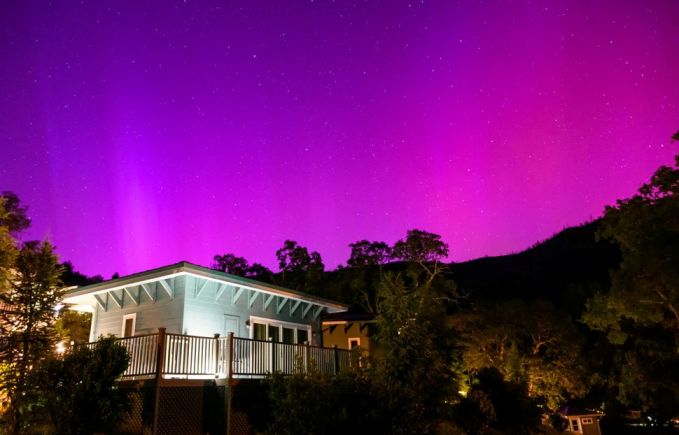
California
In Middleton, California, north of San Francisco, AFP and Getty photographer Josh Edelson captured stunning views of pink and purple lights above campers in tents and houses, while in Vienna, Austria, photojournalist Max Slovenik captured spectacular views of pink lights above the waves .
NOAA officials said that even if you can’t see the northern lights with the naked eye, many cell phones’ night sky settings can pick them up.
“Cell phones are much better at detecting light than our eyes,” Brent Gordon, head of SWPC’s space weather services division, told reporters Friday. “Just walk out the back door and take a photo with your new cell phone and you’ll be amazed at what you see in that photo compared to what you see with your own eyes.”
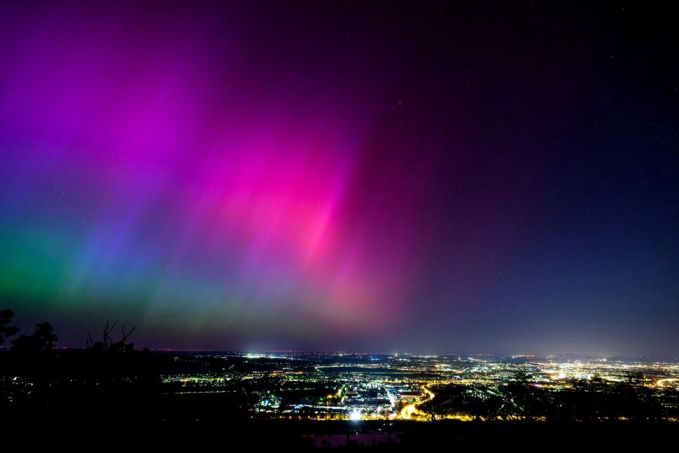
Vienna, Austria
Northern Lights Blinding Florida. With such a strong geomagnetic storm, auroras were visible from areas where the northern lights are not normally visible.
“I can write a lot about them, but I never imagined that I would see an aurora show of this magnitude over my hometown of Nottingham, UK,” Space.com magazine editor Daisy Dobrijevic said Friday evening. “I have been lucky enough to see many shows of the northern lights, but I always say that each of them is like the first time, because they are all different! This is definitely true!
Dobrijevic watched the northern lights from Sweden in the far north, but Friday night’s aurora show in her own backyard was something else entirely. “I’ve never seen so many bright colors dancing in the sky,” Dobrijevic said. “What an amazing pleasure indeed.”
Astronomer and avid aurora hunter Tom Kerss managed to capture the northern lights as far away as south Florida.
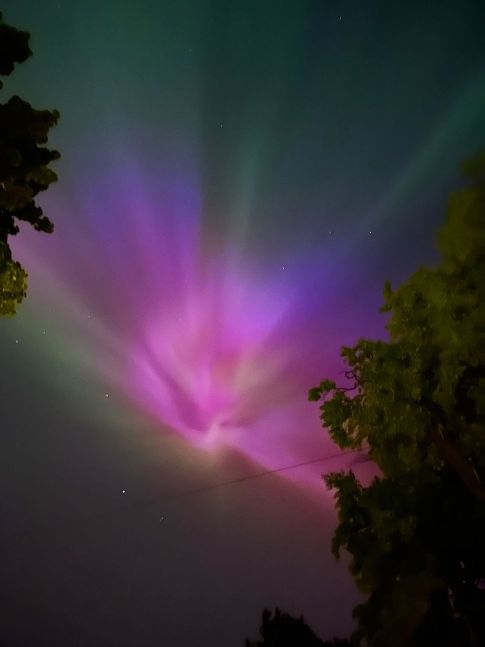
Space. com. Nottingham, UK, May 10, 2024.
“Never in my life could I imagine that I would be able to capture this! In all my years of chasing the aurora, this seemed to be the last place I would ever see it. Northern Lights in Florida! Kerss wrote in a post on X.
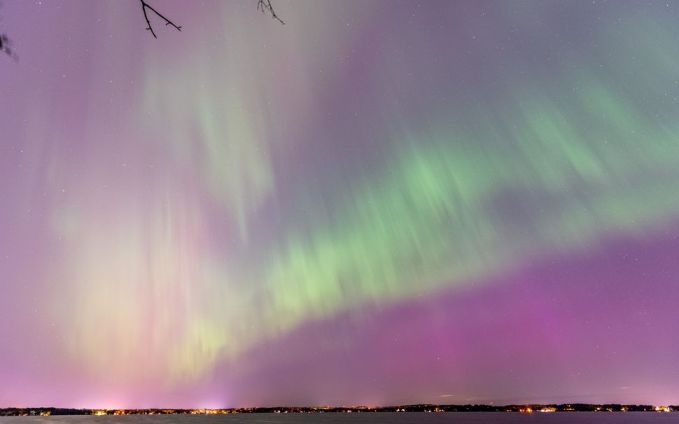
Northern Lights from Madison, Wisconsin
Earth’s northern hemisphere is not the only one where strong auroras are observed. The southern lights (or aurora australis) were visible closer to the equator than their usual locations in Antarctica, NOAA said. The result was an absolutely spectacular show for those below!
At Lake Ellesmere, near Christchurch, New Zealand, AFP photographer Sanka Widanagama captured some absolutely stunning views of the auroras, ranging from pinks and purples to stunning reds and oranges.
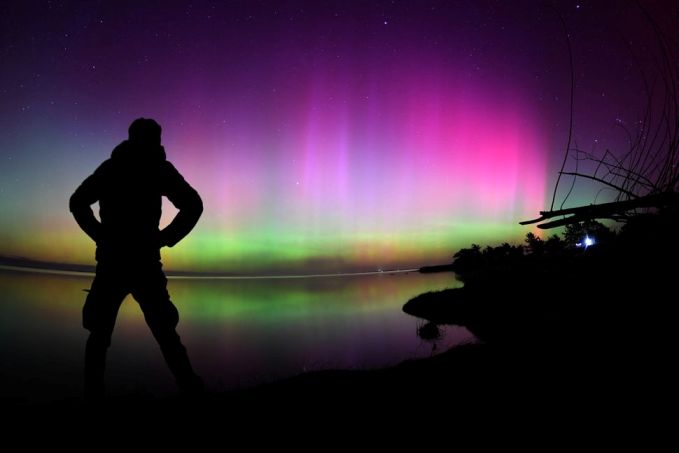
The Southern Lights, also known as the Southern Lights, glows on the horizon over the waters of Lake Ellesmere on the outskirts of Christchurch, New Zealand, May 11, 2024
“Absolutely biblical skies over Tasmania at 4am today.” Photographer Sean O’Riordan wrote in a post on X.
“I’m leaving today and knew I couldn’t miss this opportunity with such a strong solar storm. Here’s the image. I actually had to desaturate the colors. Absolutely biblical skies over Tasmania at 4am today. I’m leaving today and knew I couldn’t miss this opportunity with such a strong solar storm. Here’s the image. I actually had to desaturate the colors. The clouds glow red.”
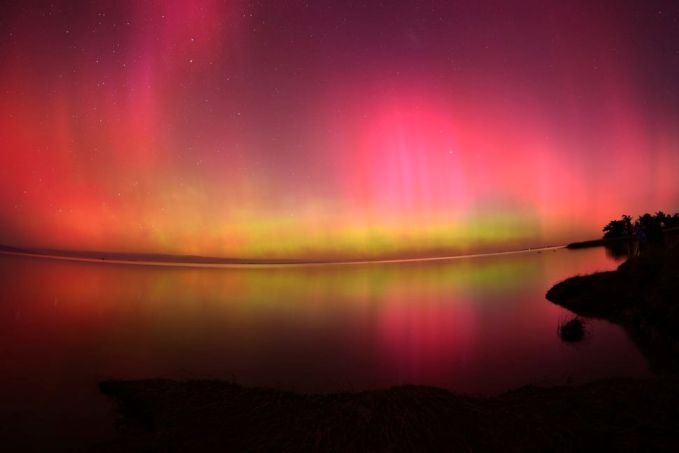
The Southern Lights, also known as the Southern Lights, glow orange and red on the horizon over the waters of Lake Ellesmere on the outskirts of Christchurch, New Zealand, May 11, 2024
Russian residents watched the northern lights for the second night in a row. It was seen in Kaliningrad, Omsk, Tyumen, Bryansk and other regions of the country, SHOT reports. The sky turned pink in Krasnaya Polyana in Sochi. The Northern Lights are observed all over the world in connection with a powerful magnetic storm.
Earlier, on the night of May 11, the magnetic storm on Earth reached an extreme power level of G5. Since yesterday evening, a magnetic storm has continued on Earth. Current level is G4 (very strong). And residents of the Saratov region could observe the polar lights yesterday at about eleven in the evening.
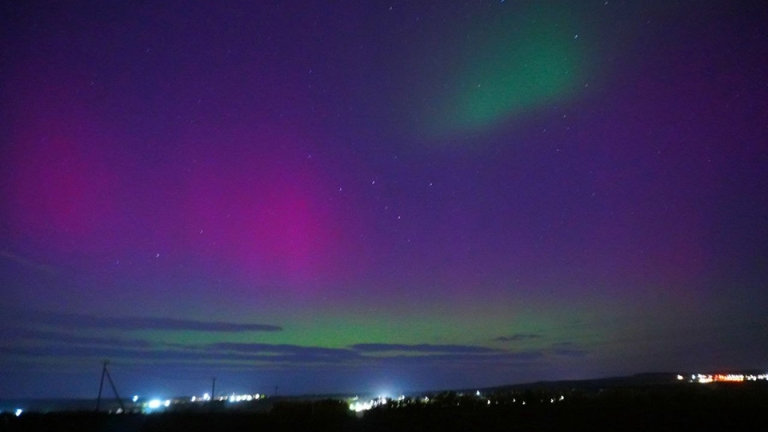
“The Earth is immersed in a cloud of plasma and will emerge from it no sooner than in a day. The total duration of the magnetic storm can be from 20 to 40 hours,” said specialists from the Solar Astronomy Laboratory of the Institute of Space Research and the ISTP of the Russian Academy of Sciences
Giant sunspot AR3664 triggers largest solar flare, causing radio blackout on Earth
The X3.98 flare peaked this morning (May 10) at 2:54 a.m. (0654 GMT), causing either a temporary or complete loss of high-frequency (HF) radio signals in Asia, Eastern Europe and East Africa.
X3.98 is not only AR3664’s largest solar flare to date, but also the fourth largest solar flare of this solar cycle, according to solar physicist Keith Strong.
Shortwave radio blackouts like those observed over Asia, Eastern Europe and East Africa are common shortly after powerful solar eruptions due to the strong pulses of X-rays and extreme ultraviolet radiation emitted during the event.
The radiation travels toward the Earth at the speed of light and ionizes (provides an electrical charge) the upper portion of the Earth’s atmosphere, creating a higher-density environment through which radio signals travel. (Note: These ionizing X-rays should not be confused with coronal mass ejections, or CMEs, which cause plasma and magnetic fields to escape from the Sun. CMEs travel at slower speeds and often take several days to reach Earth.)
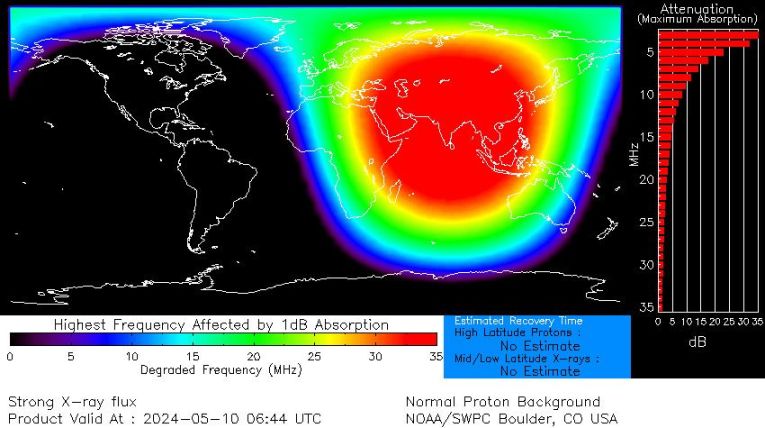
Trying to pass through this ionized layer, radio waves cannot help but interact with the electrons that have now filled the environment. At the same time, radio waves lose energy due to more frequent collisions with electrons. According to the National Oceanic and Atmospheric Administration’s (NOAA) Space Weather Prediction Center (SWPC), this could result in radio signals being degraded or completely absorbed.
Space Weather Prediction Center (SWPC)
The National Oceanic and Atmospheric Administration’s Space Weather Prediction Center (SWPC) upgraded the geomagnetic storm level to G4 this weekend, the second-highest on the scale. The change occurs as solar activity continues to remain high and at least four coronal mass ejections (CMEs) are heading towards Earth.
This level is rare, according to NOAA’s SWPC, where there is a high probability that multiple CMEs will reach Earth and create “highly enhanced” geomagnetic activity. More recently, an increase in high-level solar flares and associated CMEs has been observed in several sunspot regions, which has also increased the potential impacts of this solar activity. From late Friday through Saturday, these events impacted not only space, but also Earth in terms of our satellite communications systems and the visibility of auroras.
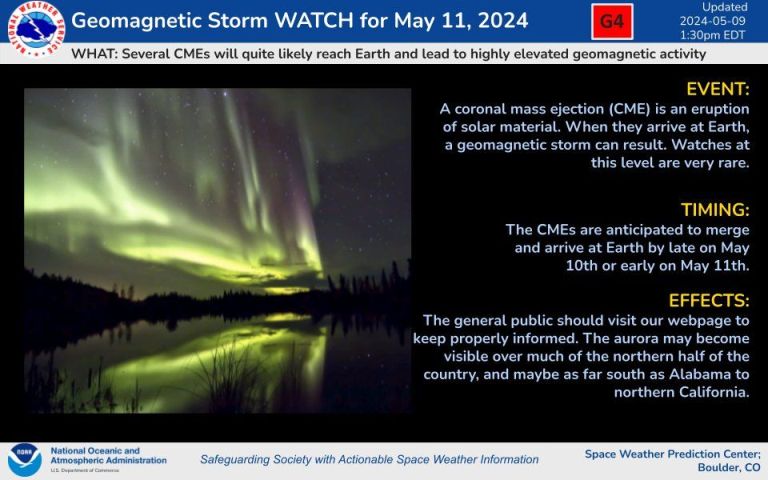
May 11 geomagnetic storm watch information provided by NOAA
Particularly at the G4 level, there is a threat of widespread voltage control problems and network impacts that could impact some protection systems. Satellite and low-frequency radio navigation systems such as GPS may fail, and spacecraft operations may also experience problems with ground charging and tracking.
Explosive sunspots – May 2024 timeline
May 3. Scientists have found that the frequency of class X flares on the Sun has increased by 60% over the past five years. According to astronomer Keith Strong, the 30th X-class flare occurred on the Sun at night as part of the current cycle of activity of the star.
American astronomer Keith Strong reported that at night the 30th X-class flare occurred on the Sun as part of the current cycle of activity of the star. This figure is almost 60% higher than the number of similar flares during a comparable period of the last solar cycle, the researcher writes in his microblog on X (formerly Twitter).
“Today at two o’clock in the morning GMT (5 o’clock Moscow time), an active region on the surface of the Sun generated another X-class flare, which became the 11th most powerful in the entire current cycle of solar activity. It was the 30th X-class flare in the last five years, while during the same period, only 19 similar manifestations of solar activity occurred during the same period within the last cycle of activity,” writes Strong.
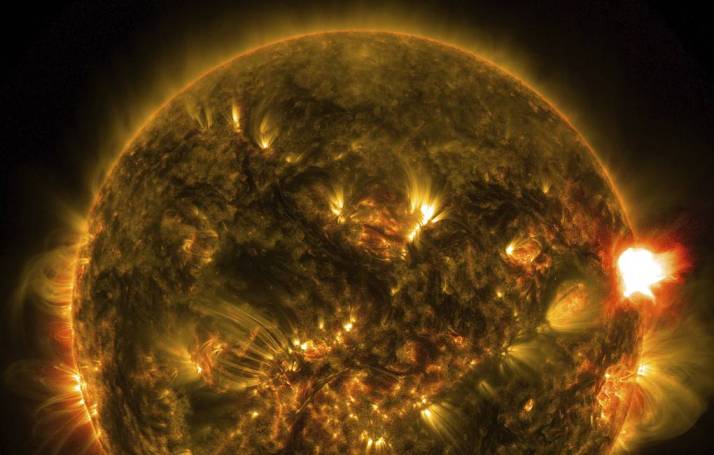
In recent days and weeks, as Strong notes, solar activity has become especially high. On May 2 alone, six coronal mass ejections occurred on the surface of the star, and the number of sunspots, reflecting the level of its activity, increased greatly in April. In total, over the past five years, the star has generated more than seven hundred flares, which is higher than the total number of manifestations of solar activity during the entire previous cycle, which lasted 11 years.
Explosive sunspot AR3663 and its larger relative AR3664 on May 8 are major solar flares, producing flare after flare. The National Oceanic and Atmospheric Administration’s (NOAA) Space Weather Prediction Center (SWPC) has issued a warning about the increased risk of solar flares due to the continued growth of sunspot AR6634, which has increased in both size and complexity.
The recent X-flare from AR3664 was accompanied by a coronal mass ejection (CME), a strong ejection of plasma and magnetic field from the Sun. But even a glancing blow from this CME into Earth’s atmosphere could trigger a geomagnetic storm, so aurora watchers should be on alert.
Geomagnetic storms, also known as solar storms, are disturbances in the Earth’s magnetic field caused by CMEs. When charged particles from the Sun crash into Earth’s atmosphere, our planet’s magnetic field forces them toward the poles. The overload of molecules in Earth’s atmosphere produces colorful displays that are typically limited to areas at high latitudes for the northern lights (northern lights) and low latitudes for the southern lights (southern lights).
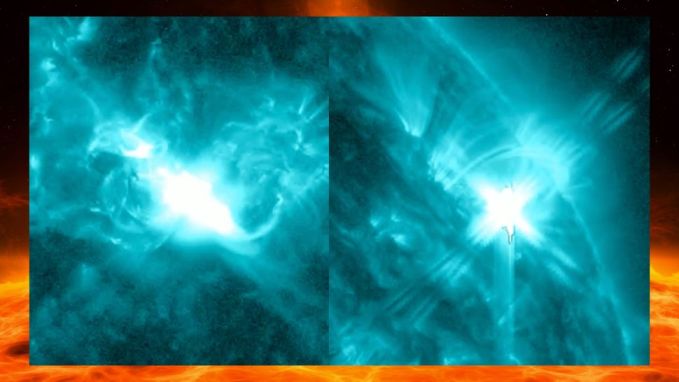
Sunspots AR3664 and AR3663 are full of solar flare activity. NASA/SDO
Scientists are keeping a close eye on both hyperactive sunspots as their flare activity doesn’t seem to be slowing down anytime soon. At the time of writing, AR3664 released another powerful M-class solar flare measuring M.69 during its peak at 08:04 ET (1204 GMT). It’s hard work keeping track of all those powerful solar flares! The sun is definitely awake as we approach solar maximum, the most active period of the roughly 11-year solar cycle.
On May 8, 10 powerful flares occurred on the Sun. As noted at the Institute of Applied Geophysics, some flares were accompanied by disruption of HF radio communications.
Scientists recorded 10 high-class M flares that occurred on the Sun on Tuesday, the Institute of Applied Geophysics (IPG) told TASS.
The first M1.3 flare was recorded at 00:48 Moscow time, its duration was 30 minutes. The last outbreak was recorded at 19:30, it turned out to be the most powerful. “On May 7 at 19:30 Moscow time, an M8.2 flare lasting 15 minutes was detected in the X-ray range in the group of sunspots 3663 (N24W56),” the report says. At the same time, according to the IPG, some outbreaks were accompanied by disruption of HF radio communications.
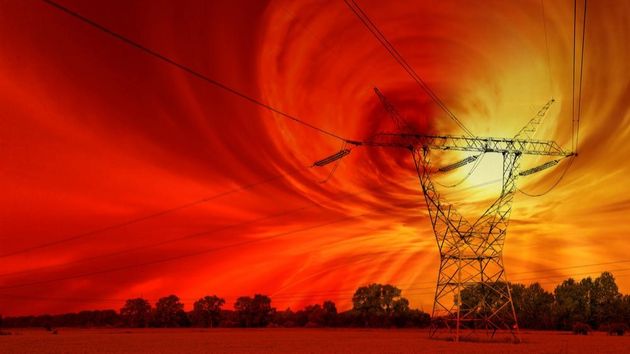
Over the past two weeks, scientists have detected four of the highest class X flares on the Sun (flares X1.7 and X4.5, as well as two flares of X1.3) and a large number of class M flares.
A total of 15 class M and X flares were recorded on May 8. Over the past two weeks, scientists have recorded six flares of the highest class X and a large number of class M flares on the Sun, according to monitoring data.
On May 9, two flares of the highest class occurred on the Sun. According to space weather monitoring, seven M-class flares have been registered on the Sun. Scientists have registered two flares of the highest class on the Sun, the Institute of Applied Geophysics reported to TASS.
The X1.0 flare occurred at 00:40 Moscow time and lasted 50 minutes. Also at 12:14 Moscow time, scientists recorded a new class X flare.
“On May 9 at 12:13 Moscow time, an X2.2 flare lasting 41 minutes was detected in the X-ray range in the group of sunspots 3664 (S20W24). The flare was accompanied by bursts of radio emission of II (V = 1004 km/sec) and IV spectral types, and disruption of HF radio communications,” the report says.
In addition, according to space weather monitoring, seven M-class flares were recorded on the Sun on Thursday. A total of eight X-class flares have occurred in the past two weeks.
Solar flares, depending on the power of X-ray radiation, are divided into five classes: A, B, C, M and X. The minimum class A0.0 corresponds to a radiation power in Earth’s orbit of 10 nanowatts per 1 square meter. m. When moving to the next letter, the power increases 10 times. Flares are usually accompanied by emissions of solar plasma, clouds of which, reaching the Earth, can provoke magnetic storms.
May 10. A new particularly large flare of the X3.9 class occurred on the Sun; it became the fourth most powerful in the last 25 years. Magnetic storms are possible on Earth on May 12-13, reported on the website of the Solar Astronomy Laboratory of the Institute of Space Research of the Russian Academy of Sciences.
“A new, particularly large solar flare is being recorded. The event is localized in the southwestern part of the solar disk, in the same active region as previous events. Preliminary power – no less than X3.9. The event is the fourth most powerful in the current 25th solar cycle,” the report said. According to scientists, there are high risks of geomagnetic consequences for the Earth on May 12-13.
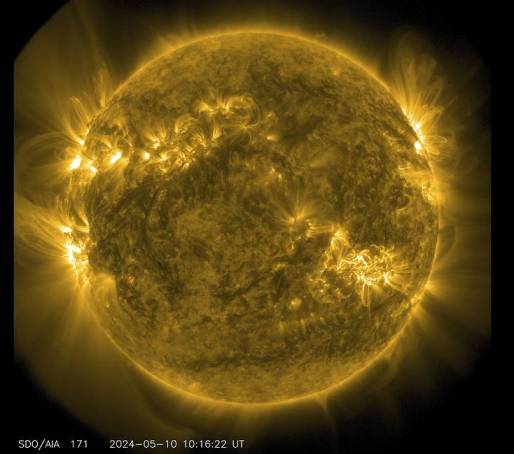
Over the past two days, six flares of the highest grade X have occurred on the Sun. Currently, the level of flare activity is about 9.8 on a scale of ten. In the next two to three days, the explosive energy will subside. Geomagnetic storms of varying degrees of strength may continue on Earth until the end of the week.
The second most powerful flare over the past seven years was registered on the Sun on the night of May 11, Sergei Bogachev, head of the solar astronomy laboratory at the Institute of Space Research of the Russian Academy of Sciences, told RIA Novosti.
“A new extremely strong flare was registered on the Sun at night. According to the data received, this is the second strongest solar explosion since 2017, that is, in seven years. At the peak of the radiation, the flare is classified as an X5.8 level event,” Bogachev said.
He added that the outbreak began at 4.10 Moscow time, its maximum was recorded at 4.23 Moscow time, and now the radiation has returned to normal.
“It is extremely difficult to identify local geomagnetic consequences of the event. The activity of the Sun is at such a level that it essentially merges into one continuous background. The flare activity index in the morning reached 10.0 on a 10-point scale, that is, it is at the maximum possible level,” the scientist noted.
Speaking about the magnetic storm currently occurring on Earth, he noted that according to currently available data, there were three impacts of the solar mass. The first strike occurred around 20.00 Moscow time on May 10 and coincided with the beginning of a G4 storm. At night, more powerful impacts occurred around 1.00 Moscow time and at 4.30 Moscow time. Everyone’s strength was equivalent to G5 level.
In the middle of the day, sharp fluctuations in geomagnetic intensity may occur due to the passage of dense solar masses past the Earth, Bogachev warned. New plasma clouds are possible during the day, he added.
May 13. Magnetic storms have been raging on Earth for four days. The magnetic storms that began on Earth last evening last Friday, May 10, and reached extreme strength, class G5, on Saturday, weakened on Sunday and stopped for a fairly long period, about 12 hours, but on Monday night they resumed again .
Last night, a mass ejection from the X5.8 flare that occurred on the morning of May 11 came to Earth. Unlike Saturday’s events, solar matter appears to pass by our planet without sudden impacts and having lost a significant part of its energy. However, just after midnight the magnetic storms reached the average G2 level. At the moment, the Kp index, which shows the degree of geomagnetic field disturbance, is 5 units, which corresponds to a weak magnetic storm of level G1.
According to the website of the Laboratory of Solar Astronomy of the Institute of Space Research of the Russian Academy of Sciences and ISTP SB RAS, it is expected that in the first half of today, magnetic storms for a short time can still reach the average and even strong level G2-G3, but in the second half of Monday they will weaken and stop. At the same time, the formation of short-term magnetic storms of weak intensity of class G1 is also possible on Tuesday.
Magnetic Storm Maximum Level Announcements
A magnetic storm of the highest (fifth) level is happening on Earth, the last time this happened was 20 years ago, Sergei Bogachev, head of the Solar Astronomy Laboratory of the Institute of Space Research of the Russian Academy of Sciences, told RIA Novosti. “There is a magnetic storm of the highest level on Earth. After a 20-year break. Level G5,” Bogachev said.
In the United States, for the first time since 2003, the assessment of the strength of a magnetic storm was raised to maximum. For the first time since 2003, the US Meteorological Service has raised to its maximum level the assessment of the strength of a geomagnetic storm that reached the Earth, the organization said in a statement.
“Extreme conditions at the G5 level reached the Earth at 6.54 pm Eastern time (01:54 Moscow time on Saturday – Ed.). The geomagnetic storm will most likely persist throughout the weekend,” the message said.
It is noted that the last time the maximum level of assessment of a geomagnetic storm was established in October 2003. The power of magnetic storms is assessed on a five-point scale. Storms of level G1 are considered the weakest; they have almost no effect on the operation of electrical appliances. Level G3 is a severe storm, it directly affects power systems and causes interruptions in satellite navigation and radio communications. The maximum level is G5, large-scale problems with the power grid and serious malfunctions in the operation of satellites and radio communications are possible.
Interesting space probes and devices
The Parker solar probe was launched on August 12, 2018. Since then, the probe’s elliptical orbit has allowed it to enter the solar corona closer than ever before. In fact, it became the first artificial object to enter the outer atmosphere of the Sun. 11.5 solar radii from the surface of the Sun.
And even now the Parker solar probe has not entered its final orbit. The probe repeatedly flew past Venus to use the planet’s gravity to increase speed and narrow its orbit around the Sun. This November, the probe will fly past Venus for the seventh time, once again tightening its loop around the Sun, putting it within just 9.5 solar radii of the Sun in 2025 and beyond.
NASA: From time to time, the Sun’s boiling magnetic field throws colossal clouds of plasma into space. These are so-called coronal mass ejections (CMEs). For example, if one CME hits Earth, the result could be spectacular auroras—and equally spectacular disruptions to electrical grids and satellites.
Now NASA’s Parker solar probe has been able to peer inside a CME for the first time in history as it bursts from the Sun. And what’s inside appears to be a treasure trove for solar physicists. Parker Solar Probe’s Wide-Angle Visible Light Detection Instrument (WISPR) captured distinct turbulent eddies within the CME.
Whirlpools are what physicists call Kelvin-Helmholtz instability (KHI). Physicists believe that KHI events occur whenever one section of fast-moving fluid interacts with another. On Earth, KHI occurs in clouds when the wind speed at one end of the cloud is different than the wind speed at the other end.
Solar physicists have concluded that KHI exists in CMEs because plasma in CMEs moves counter to the background solar wind. But they never had the right equipment in the right place to observe these phenomena.
“The turbulence that produces KHI plays a fundamental role in regulating the dynamics of CMEs flowing through the ambient solar wind,” Evangelos Paouris, a solar physicist at George Mason University, said in a statement. “Hence, understanding turbulence is key to achieving a deeper understanding of the evolution and kinematics of CMEs.”
Solar Orbiter and Parker solar probe. ESA and NASA are teaming up to study the solar wind. Ahead of April’s total solar eclipse, ESA’s Solar Orbiter and NASA’s Parker Solar Probe were at their closest approach to the Sun. They then teamed up to study the torrential rain of plasma that pours from the Sun, fills the solar system and causes blinding and destruction on Earth.
Both Solar Orbiter and Parker Solar Probe have highly eccentric orbits, meaning they fly close to the Sun to get a close-up view of it, then fly far away to give their onboard technologies a chance to recover from extreme heat and radiation. Within a week, the two spacecraft simultaneously reached their closest approach to the Sun—what we call “perihelion.”

Solar Orbiter: working in extreme conditions
ESOC teams used a recent period of low latency communications with Solar Orbiter to test whether they were prepared to handle a real burst recovery.
Moreover, this closest approach coincides with Solar Orbiter and Solar Probe Parker being at right angles to each other when they look at the Sun.
Daniel Müller, ESA Solar Orbiter project scientist, explains why this positioning is special. “On this day, we have a unique spacecraft configuration where the full complement of Solar Orbiter instruments will be pointed at the region of the Sun where the solar wind is generated and will hit the Parker Solar Probe in a few hours.”
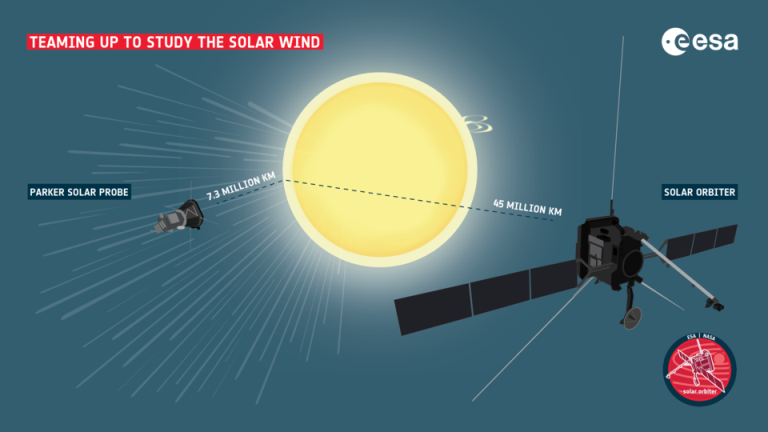
Scientists will compare data collected by both missions to better understand the properties of the solar wind. Since Solar Orbiter is closest to the Sun, its telescopes will observe at the highest resolution. The simultaneous close approach of the Parker Solar Probe means that just hours after solar wind sources were sampled by Solar Orbiter, plasma from this nearly pristine solar wind will be sampled in space by the Parker Solar Probe. This will allow scientists to better understand the connection between the Sun and its heliosphere – the huge bubble of plasma that it ejects into space.
But wait… at its closest approach, Solar Orbiter is 45 million km from the Sun, while the Parker Solar Probe is only 7.3 million km away. So how does Solar Orbiter observe what later ends up in the Parker Solar Probe?
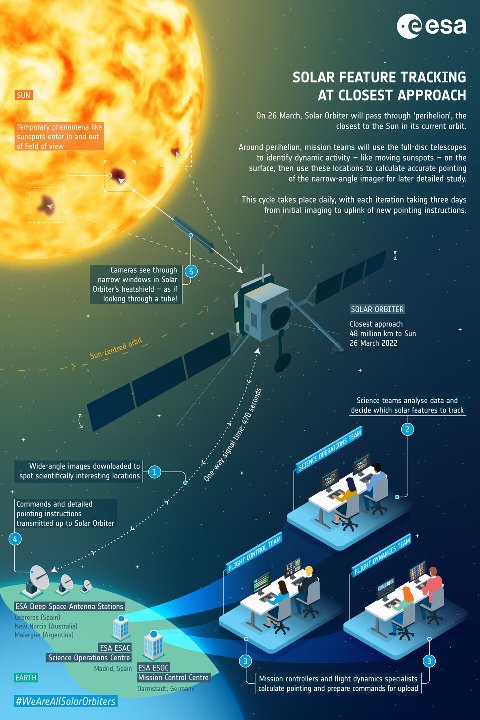
To answer this question, we need to look at the difference between remote sensing and in situ instruments. Both missions have both types of instruments on board, but while Solar Orbiter has more remote sensing instruments, Parker Solar Probe has mostly in situ instruments (no current camera technology can look at the Sun that close and survive).
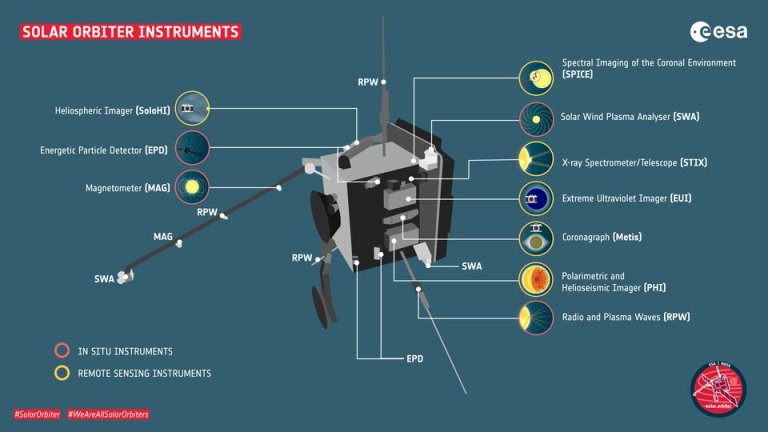
Remote sensing instruments work like a camera or our eyes; they detect light waves coming from the Sun at different wavelengths. Because light travels at 300,000 km/s, it takes 2.5 minutes to reach Solar Orbiter instruments at its closest approach.
Meanwhile, Parker Solar Probe devices work more like our nose or taste buds. They directly “sample” particles and fields in the immediate vicinity of the spacecraft. In this case, Parker Solar Probe will measure solar wind particles that are moving away from the Sun at speeds of more than a million kilometers per hour. Although this seems very fast, it is actually more than 500 times slower than the speed of light.
“In principle, only Solar Orbiter can use both methods,” notes Andrei Zhukov of the Royal Observatory of Belgium, who is working on the joint observations. “However, Parker Solar Probe comes much closer to the Sun, so it can directly measure the properties of the solar wind—such as its density and temperature—closer to its birthplace, before those properties change on its way away from the Sun.”
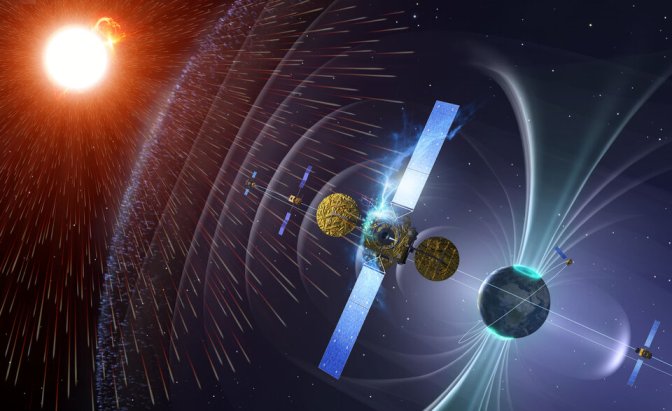
“We will really hit the jackpot if Solar Orbiter detects a coronal mass ejection (CME) heading towards the Parker Solar Probe,” Andrey adds. “We will then be able to see the restructuring of the Sun’s outer atmosphere during the CME in great detail and compare these observations with the structure observed in situ by the Parker Solar Probe.”
This is just one example of how Solar Orbiter and Parker Solar Probe work together during their missions. The Parker Solar Probe instruments are designed to sample the solar corona (its outer atmosphere), targeting the region of space where the coronal plasma breaks away and becomes the solar wind. This gives scientists direct data on the state of the plasma in the region and helps determine exactly how it accelerates towards the planets.
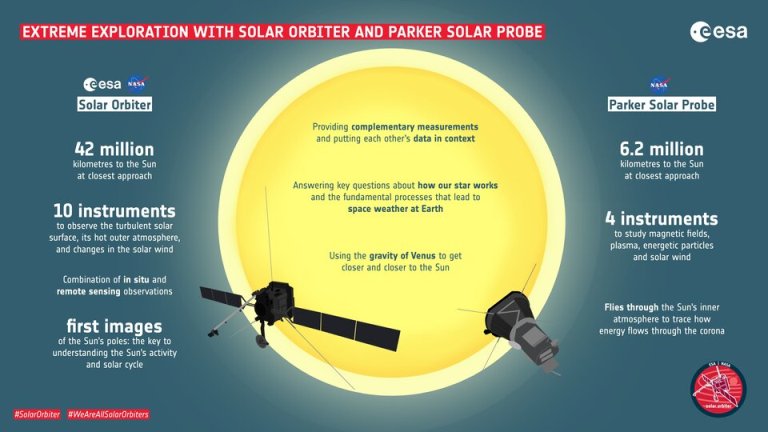
In addition to achieving its own science goals, Solar Orbiter will provide contextual information to improve understanding of Parker Solar Probe’s measurements in situ. By working together in this way, the two spacecraft will collect complementary data sets, allowing more science to be extracted from the two missions than either could obtain separately.
A secret spacecraft will monitor the activity of the Sun
Europe’s newest rocket is about to launch and will take it on many space missions. CURIE, NASA’s Cubesat radio interferometry experiment, is one such payload launched on the maiden flight of Ariane 6. CURIE will measure radio waves emanating from the Sun and other radio sources in the sky. Such waves must be measured in space because they are absorbed by the Earth’s ionosphere, a region extending 30 to 600 miles above the Earth’s surface made of ionized (charged) gases and created when solar radiation interacts with the upper atmosphere.
CURIE consists of two spacecraft that will be launched together as one and then split into two in orbit. From different perspectives, the CURIE A and B satellites will make it possible to measure the same radio waves from two places at the same time. Using radio interferometric analysis techniques, it is possible to reconstruct the origin of detected radio waves.
CURIE’s main scientific goal is to use radio interferometry to study radio bursts from solar eruptions, such as flares and coronal mass ejections in the inner heliosphere. These events determine space weather, and their effects are felt on Earth and other planets when they occur through increased polar activity and geomagnetic effects.
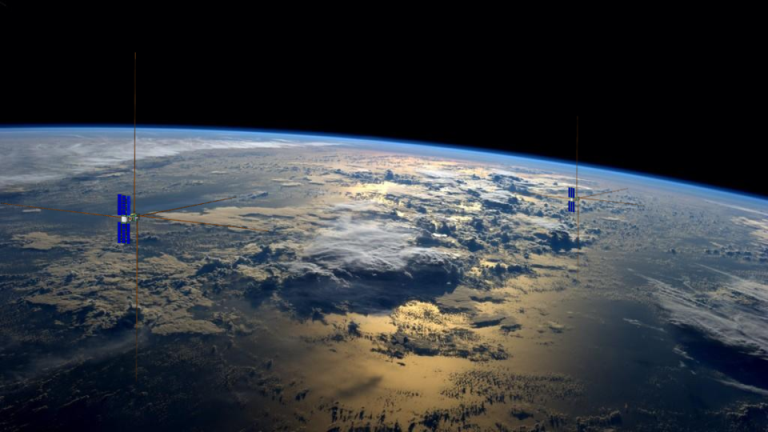
Image of CURIE in flight
CURIE will be able to determine the location and size of radio burst source areas and then track their movement away from the Sun.
Such a space-based radio interferometry observatory has long been envisioned in orbit around the Earth or the Moon, or on the far side of the Moon. CURIE will be the first mission of its kind to measure radio waves in the frequency range 0.1-19 MHz from space. It will serve as an experimental platform and pioneer in the development of new spaceborne radio observation techniques important for our understanding of heliospheric space weather and the impact of the Sun on the planets of the Solar System.
In addition to its important scientific goals, CURIE will also prove that the concept of a dedicated space interferometer can be realized using relatively low-cost CubeSats.

CURIE in a clean room
The launch of Ariane 6 is scheduled for June-July 2024. It follows the hugely successful Ariane 5, Europe’s flagship rocket for more than a quarter of a century, which made 117 flights between 1996 and 2023 from Europe’s spaceport in French Guiana.
Ariane 6 was designed with all possible futures in mind. It is based on maximum versatility. It can launch any satellite or payload into any orbital path. This is made possible by the new restartable Vinci engine, which will power Ariane 6’s upper stage over and over again, stopping and starting missions to whatever orbit they need. This would save enough fuel for final combustion to deorbit and return safely back through Earth’s atmosphere or return to a nearby “graveyard orbit.”

An artist’s take on the fairing section of an Ariane 6
CURIE will enter a low-Earth circular orbit, flying at an altitude of 580 km above the Earth’s surface, outside the radio-absorbing ionosphere of our planet.
“When we were awarded a seat on the first flight of Ariane 6, the CURIE team was very excited. This is such a big event in the world of rocketry and space exploration,” recalls David Sundquist, the mission’s principal investigator.
“For the team developing a new concept – a flying satellite radio interferometer – launching a new European rocket on its maiden flight is like a satellite designer’s dream come true.”
A giant radio telescope has been created in China to observe the solar wind.
The facility is located in the Inner Mongolia Autonomous Region in northern China. China has completed construction of a giant radio telescope to observe the flow of charged particles coming from the Sun. The powerful astronomical instrument successfully passed technical tests on Friday, Xinhua reported.
The project was supervised by the National Space Research Center of the Chinese Academy of Sciences. The facility is located in the Inner Mongolia Autonomous Region in northern China.
Thanks to this telescope, Chinese specialists will conduct daily observations of fluctuations in radio signals from distant sources under the influence of the solar wind. It is expected that such monitoring will make it possible to respond in a timely manner to changes in the magnetosphere and ionosphere, which have a negative impact on aviation, aerospace projects, communications, navigation instruments and the operation of power systems.




